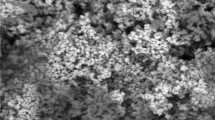Abstract
Herein, we reported a green biosynthesis method of copper nanoparticles (CuNPs) at microwave irradiation condition by using pectin as a stabilizer and ascorbic acid as a reducing agent. Under the optimum conditions, CuNPs1 and 2 were synthesized under microwave times 0 and 3 min, respectively. Transmission electron microscope and scanning electron microscope (SEM) tests showed that CuNPs1 and 2 had irregular polygon particles with average diameters of 61.9 ± 19.4 and 40.9 ± 13.6 nm, respectively. Zeta potentials of CuNPs1 and 2 were −45.2 and −48.7 mV, respectively. X-ray diffraction, Fourier transform infrared spectroscopy (FTIR), thermogravimetric analysis (TGA), and X-ray photoelectron spectroscopy techniques were used to characterize the properties of CuNPs. Furthermore, inhibition zone tests showed that CuNPs2 exhibited higher antimicrobial activities against Escherichia coli, Staphylococcus aureus, and Aspergillus japonicus than CuNPs1. The antibacterial activities were also studied by the bacterial growth kinetics in broth media, and CuNPs2 exhibited lower minimum bactericidal concentrations than CuNPs1.







Similar content being viewed by others
References
Suarez-Cerda J, Espinoza-Gomez H, Alonso-Nunez G, Rivero IA, Gochi-Ponce Y, Flores-Lopez LZ (2017) A green synthesis of copper nanoparticles using native cyclodextrins as stabilizing agents. J Saudi Chem Soc 21:341–348
Musa A, Ahmad MB, Hussein MZ, Saiman MI, Sani HA (2017) Preparation, characterization and catalytic activity of biomaterial-supported copper nanoparticles. Res Chem Intermediat 43:801–815
Dong C, Cai H, Zhang X, Cao C (2014) Synthesis and characterization of monodisperse copper nanoparticles using gum acacia. Physica E 57:12–20
Zain NM, Stapley AGF, Shama G (2014) Green synthesis of silver and copper nanoparticles using ascorbic acid and chitosan for antimicrobial applications. Carbohydr Polym 112:195–202
Keihan AH, Veisi H, Veasi H (2017) Green synthesis and characterization of spherical copper nanoparticles as organometallic antibacterial agent. Appl Organomet Chem 31:e3642
Venkatakrishnan S, Veerappan G, Elamparuthi E, Veerappan A (2014) Aerobic synthesis of biocompatible copper nanoparticles: promising antibacterial agent and catalyst for nitroaromatic reduction and C–N cross coupling reaction. Rsc Adv 4:15003–15006
Bashir O, Hussain S, Al-Thabaiti SA, Khan Z (2015) Synthesis, optical properties, stability, and encapsulation of Cu-nanoparticles. Spectrochim Acta Part A 140:265–273
Zahran MK, Ahmed HB, El-Rafie MH (2014) Facile size-regulated synthesis of silver nanoparticles using pectin. Carbohydr Polym 111:971–978
Zhang W, Zhao XJ, Jiang Y, Zhou Z (2017) Citrus pectin derived silver nanoparticles and their antibacterial activity. Inorg Nano Met Chem 47:15–20
Su D-l, Li P-j, Ning M, Li G-y, Shan Y (2019) Microwave assisted green synthesis of pectin based silver nanoparticles and their antibacterial and antifungal activities. Mater Lett 244:35–38
Nadezhda VI, Natalya NT, Lydmila AEK, Vasilyi AB (2012) The study of the reaction of pectin-Ag(0) nanocomposites formation. Int J Carbohydr Chem 2012:ID459410
Li BJ, Li YY, Wu YH, Zhao YB (2014) Synthesis of water-soluble Cu/PAA composite flowers and their antibacterial activities. Mat Sci Eng C-Mater 35:205–211
Baranwal A, Srivastava A, Kumar P, Bajpai VK, Maurya PK, Chandra P (2018) Prospects of nanostructure materials and their composites as antimicrobial agents. Front Microbiol 9:422
Chen J, Wang J, Zhang X, Jin Y (2008) Microwave-assisted green synthesis of silver nanoparticles by carboxymethyl cellulose sodium and silver nitrate. Mater Chem Phys 108:421–424
Ngoan Thi N, Binh Hai N, Duong Thi B, Dien Gia P, Van Tran K, Loc Thai N, Lam Dai T (2014) Microwave-assisted synthesis of silver nanoparticles using chitosan: a novel approach. Mater Manuf Process 29:418–421
Kahrilas GA, Wally LM, Fredrick SJ, Hiskey M, Prieto AL, Owens JE (2014) Microwave-assisted green synthesis of silver nanoparticles using orange peel extract. ACS Sustain Chem Eng 2:367–376
Rufus SNA, Philip D (2016) Microwave-assisted rapid synthesis of copper nanoparticles with exceptional stability and their multifaceted applications. J Mol Liq 221:1008–1021
Li P-j, Xia J-l, Nie Z-y, Shan Y (2016) Pectic oligosaccharides hydrolyzed from orange peel by fungal multi enzyme complexes and their prebiotic and antibacterial potentials. LWT Food Sci Technol 69:203–210
Ahmed HB, Zahran MK, Emam HE (2016) Heatless synthesis of well dispersible Au nanoparticles using pectin biopolymer. Int J Biol Macromol 91:208–219
Hanaor D, Michelazzi M, Leonelli C, Sorrell CC (2012) The effects of carboxylic acids on the aqueous dispersion and electrophoretic deposition of ZrO2. J Eur Ceram Soc 32:235–244
Lv Q, Zhang B, Xing X, Zhao Y, Cai R, Wang W, Gu Q (2018) Biosynthesis of copper nanoparticles using Shewanella loihica PV-4 with antibacterial activity: novel approach and mechanisms investigation. J Hazard Mater 347:141–149
Wang Z, Chen M, Shu J, Li Y (2016) One-step solvothermal synthesis of Fe3O4@Cu@Cu2O nanocomposite as magnetically recyclable mimetic peroxidase. J Alloy Compd 682:432–440
Usman MS, El Zowalaty ME, Shameli K, Zainuddin N, Salama M, Ibrahim NA (2013) Synthesis, characterization, and antimicrobial properties of copper nanoparticles. Int J Nanomed 8:4467–4478
Jomova K, Baros S, Valko M (2012) Redox active metal-induced oxidative stress in biological systems. Transit Metal Chem 37:127–134
Mishra S, Singh BR, Singh A, Keswani C, Naqvi AH, Singh HB (2014) Biofabricated silver nanoparticles act as a strong fungicide against bipolaris sorokiniana causing spot blotch disease in wheat. PLoS ONE 9:e97881
Marambio-Jones C, Hoek EV (2010) A review of the antibacterial effects of silver nanomaterials and potential implications for human health and the environment. J Nanopart Res 12:1531–1551
Acknowledgements
This study was financially supported by a grant from the Middle-aged and Young Teachers’ Basic Ability Promotion Project of Guangxi (No. 2018KY0257), the Research Program of Guangxi Specially-invited Experts (Ting Fa [2018] 39th), the Guangxi Key Laboratory of Electrochemical and Magneto-chemical Functional Materials (EMFM 20162204), and Guangxi Science and Technology Base and Specialized Talents (AD19110074). The authors appreciate Ms. Liao Li-qiong for editing the figures in this manuscript.
Author information
Authors and Affiliations
Corresponding authors
Ethics declarations
Conflict of interest
The authors declare no financial or commercial conflict of interest.
Additional information
Publisher's Note
Springer Nature remains neutral with regard to jurisdictional claims in published maps and institutional affiliations.
Rights and permissions
About this article
Cite this article
Li, Pj., Liang, Jy., Su, Dl. et al. Green and efficient biosynthesis of pectin-based copper nanoparticles and their antimicrobial activities. Bioprocess Biosyst Eng 43, 2017–2026 (2020). https://doi.org/10.1007/s00449-020-02390-w
Received:
Accepted:
Published:
Issue Date:
DOI: https://doi.org/10.1007/s00449-020-02390-w




